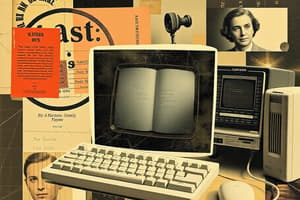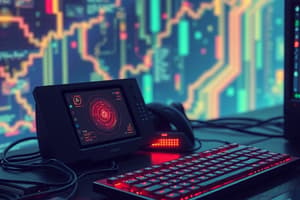Podcast
Questions and Answers
Which input device is primarily used to convert printed text into digital text?
Which input device is primarily used to convert printed text into digital text?
- Barcode Scanner
- MIDI Keyboard
- Motion Sensors
- Optical Character Recognition (OCR) Scanner (correct)
Motion sensors can only be used in gaming applications.
Motion sensors can only be used in gaming applications.
False (B)
Name one factor that impacts the selection of an input device.
Name one factor that impacts the selection of an input device.
Accuracy
A ___________ is used by musicians to create and control music.
A ___________ is used by musicians to create and control music.
Match the following input devices with their primary functions:
Match the following input devices with their primary functions:
Which input device primarily allows for text input and commands?
Which input device primarily allows for text input and commands?
A joystick is primarily used for typing documents.
A joystick is primarily used for typing documents.
What is the primary function of a microphone in a computer system?
What is the primary function of a microphone in a computer system?
A device that converts physical documents into a digital format is called a ______.
A device that converts physical documents into a digital format is called a ______.
Which of the following types of mice relies on a laser for tracking?
Which of the following types of mice relies on a laser for tracking?
Match the input device with its primary function:
Match the input device with its primary function:
All scanners can only capture images from paper documents.
All scanners can only capture images from paper documents.
What is one advantage of using a stylus with a touchscreen device?
What is one advantage of using a stylus with a touchscreen device?
Flashcards
Input Devices
Input Devices
Devices that allow users to input data, instructions, or commands into a computer. They translate human-readable input into digital signals the computer understands.
Keyboard
Keyboard
A device primarily used for typing text and entering commands. It features keys for letters, numbers, symbols, and special functions.
Mouse
Mouse
A pointing device used for selecting objects, navigating menus, and executing commands on a GUI. It uses various tracking mechanisms to determine its position.
Touchscreen
Touchscreen
Signup and view all the flashcards
Microphone
Microphone
Signup and view all the flashcards
Scanner
Scanner
Signup and view all the flashcards
Digital Camera
Digital Camera
Signup and view all the flashcards
Joystick
Joystick
Signup and view all the flashcards
Barcode Scanner
Barcode Scanner
Signup and view all the flashcards
OCR Scanner
OCR Scanner
Signup and view all the flashcards
MIDI Keyboard
MIDI Keyboard
Signup and view all the flashcards
Motion Sensors
Motion Sensors
Signup and view all the flashcards
Ergonomics
Ergonomics
Signup and view all the flashcards
Study Notes
Introduction
- Input devices are components of a computer system that allow users to enter data, instructions, and commands into a computer.
- They translate human-readable input into computer-understandable digital signals.
- Examples range from simple keyboards and mice to complex scanners and touchscreens.
Key Input Devices and Their Functions
- Keyboard:
- Used for text input and commands.
- Different layouts (e.g., QWERTY, Dvorak) exist, impacting typing speed and efficiency.
- Features like number pads, special function keys (e.g., F1-F12), and arrow keys are common.
- Mouse:
- A common pointing device that allows users to select objects, navigate menus, and execute commands on a graphical user interface (GUI).
- Various types such as optical, laser, and mechanical mice exist, differing in their tracking mechanisms.
- Often includes buttons for additional control.
- Touchscreen:
- An input device that responds to physical touch, allowing users to interact with a computer's display through gestures or direct fingertip contact.
- Common in tablets, smartphones, and some laptops.
- Intuitive but susceptible to accidental touches if not carefully used.
- Microphone:
- Captures sound input, enabling users to record voice data, communicate via voice commands, or use audio input for applications like music creation and voice recognition.
- Types vary in sensitivity and frequency response.
- Essential for voice-activated software and applications.
Other Commonly Used Input Devices
- Scanner:
- Converts physical documents, images, or objects into digital format.
- Commonly used for document digitization and image capture for computers.
- Can scan various media, including paper, film, photos, and text.
- Digital Camera:
- Records images and videos that can be transferred to a computer for editing and storage.
- Often used in photography and videography.
- Modern cameras offer features such as image stabilization and high-resolution sensors.
- Joystick:
- Used primarily for video games or specific applications requiring precise movement control.
- Provides directional inputs and often button presses.
- Leveraging a stick-like mechanism for movement.
- Stylus:
- A pen-like tool used with touchscreens or tablet computers.
- Provides precision input, similar to a pen on paper.
- Specific to digital drawing, note-taking, and other applications.
Specialized Input Devices
- Barcode Scanner:
- Reads barcodes to identify items and objects, frequently used in retail inventory control.
- Uses optical technology.
- Speeds up inventory management and order processing.
- Optical Character Recognition (OCR) Scanner:
- Converts printed text into digital text that can be edited.
- Useful for organizing and digitizing documents, making them searchable.
- Often needed to input existing printed materials into a computer.
- MIDI Keyboard:
- Used by musicians and sound designers to create and control music and sounds.
- Transmits digital musical data directly to sound synthesizers.
- Permits precise control over musical instrumentation.
- Motion Sensors (Kinect-like):
- A range of sensors for the detection and measurement of motion.
- Allow users to interact with computers using movements.
- Common in gaming and specialized applications.
Input Device Considerations
- Accuracy: Desired accuracy of input data depends on the application.
- Speed: Input speed varies depending on the device and user needs.
- Portability: Devices like tablets and smartphones often require portability, whereas large-scale digitizing scanners may not.
- Cost: The cost of input devices varies based on desired features and functionalities, e.g., expensive vs affordable scanners.
- Ergonomics: Consideration of user comfort when choosing input devices reduces user fatigue.
Summary
- Input devices are essential for interacting with and providing data to a computer.
- A variety of devices exist, each serving specific input needs.
- Factors like accuracy, speed, cost, and ergonomics impact input device selection.
Studying That Suits You
Use AI to generate personalized quizzes and flashcards to suit your learning preferences.




